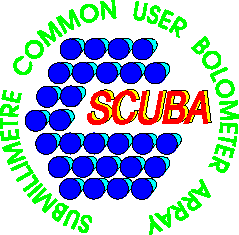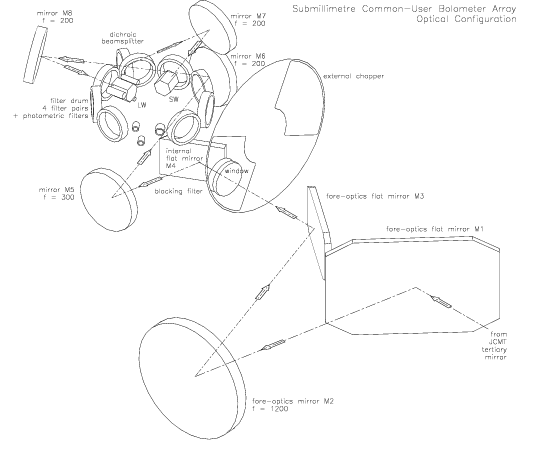| Joint Astronomy Centre | |||
| Show document only |
One of the major considerations in the design of SCUBA is to minimize the thermal loading on the bolometers due to radiation from the sky, telescope and instrument itself - thus maximising the detector sensitivity (see Holland et al. in Technical Publications section). This is accomplished by use of narrow-band filters and single-moded optics, the latter incorporating a conical feedhorn and circular waveguide to feed the bolometer in a cavity. The most efficient coupling to the telescope diffraction spot is achieved by a horn of opening  , where F is the focal ratio of the optics.
Since this consideration sets the physical size (and the cryogenic
requirements) of the of the bolometer array, the optical
configuration (below) is designed to reduce the focal ratio. , where F is the focal ratio of the optics.
Since this consideration sets the physical size (and the cryogenic
requirements) of the of the bolometer array, the optical
configuration (below) is designed to reduce the focal ratio.
The overall optical configuration of SCUBA is shown below. A system of mirrors, figured to complex shapes, is used to modify the focal ratio and provide a compact design. Mirrors are used, rather than lenses, to reduce losses and thermal loading.
SCUBA is to mounted at the left Nasmyth focus of the JCMT. In order to avoid truncation of the full field of view by the elevation axis port, during the use of SCUBA the secondary mirror is moved from the nominal focus position to modify the F-ratio from F/12 to F/16. A corrector plate within the dewar window removes the subsequent spherical aberration. Gaussian beam optics decrease the F-ratio to F/4 at the arrays in order to reduce the size of the individual feedhorns, and provide frequency-independent positions for the arrays. The final physical dimension of the diffraction spot (and horn opening) is about 6mm at 850 micron wavelength, and about half as much at 450 micron . The focal length of the optics within the dewar is maintained at 200mm. A folding flat mirror just within the dewar window has a hole at its centre corresponding to the image of the secondary mirror, and an internal calibrator (in the form of an inverse bolometer) positioned here. After another two reflections (from mirrors of focal length 200mm) the beam reaches a fixed dichroic beam-splitter which has better than 97% transmission/reflectance. This therefore enables SCUBA to take data with both arrays simultaneously. Positioned just in front of the arrays is a filter carousel, or drum, which allows particular combinations of wavebands to be observed. However this option is not currently available due to engineering problesm with the drum. |

